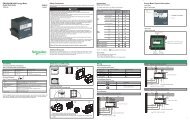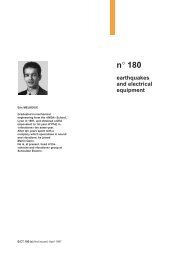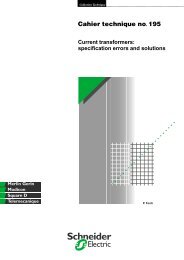Low Voltage circuit-breaker breaking techniques - Schneider Electric
Low Voltage circuit-breaker breaking techniques - Schneider Electric
Low Voltage circuit-breaker breaking techniques - Schneider Electric
- No tags were found...
Create successful ePaper yourself
Turn your PDF publications into a flip-book with our unique Google optimized e-Paper software.
4 Breaking steady-state currentsSteady-state currents are rated currents,overload currents and short-<strong>circuit</strong> currentswhich have reached a stable value on <strong>circuit</strong>opening.Circuit opening may be:c voluntary, controlled by the user, completelyseparate from current value;c "reflex", by the action of a device affected bycurrent value and directly or indirectly controlling<strong>circuit</strong> opening.For simplicity's sake, <strong>breaking</strong> conditions areexamined :c in d.c. voltage;c then in a.c. voltage.4.1 In DC supplyu = Ebefore opening: i 0= E/Rafter opening: E - R i - L di/dt - u a= 0When the contacts open, u amoves towards amaximum value Ua (see fig. 7 ).Ohm's extended law shows that current can onlybe forced to "0" if u abecomes greater than E.Otherwise, it will move toi’ 0= (E - Ua)/R, not zero.For current <strong>breaking</strong> purposes, it is thus easierand sufficiently clear to consider this arcingvoltage as a step function, u a= U afor t > t 0,(t 0= instant when u a= E).The complete calculation then yields:E, rUUaLRi =aER - U aR⎛ −t⎞1−eτand t a =⎜ ⎟⎝ ⎠Uaτ LogU -Eremembering that <strong>breaking</strong> occurs as soon asthe current passes through zero (a «negative»current due to dominance of Ua compared withUr has no physical significance).Calculation of the integral:at aWa = ∫ u a i a dtτ0givesuaEi,ui 0t 0Uai aUaUrt⎛ 1 Ua Ua UaWa=Log2 Li 0 2 ⎞ ⎡ ⎛ ⎞⎤⎜ ⎟ 2 1 1⎝ ⎠⎢ + ⎜ − ⎟E ⎝ E ⎠⎥⎣Ua−E⎦It is easier to interpret this expression by writing:W L0= (1/2 L i 2 0) and observing the curves (Wa/W L0), and(t a/τ) as a function of (U a /E), (see fig. 8 ).These curves show:WaW L021.510.5WaWL0ta__ τta__ τ21.510.5t 0t at0.2 1 1.5 2 3 5 10"optimum"U aEFig. 7: <strong>breaking</strong> under dc voltage.Fig. 8: curves Wa/W L0 and t a /τ.Cahier Technique <strong>Schneider</strong> <strong>Electric</strong> no. 154 / p.10
















